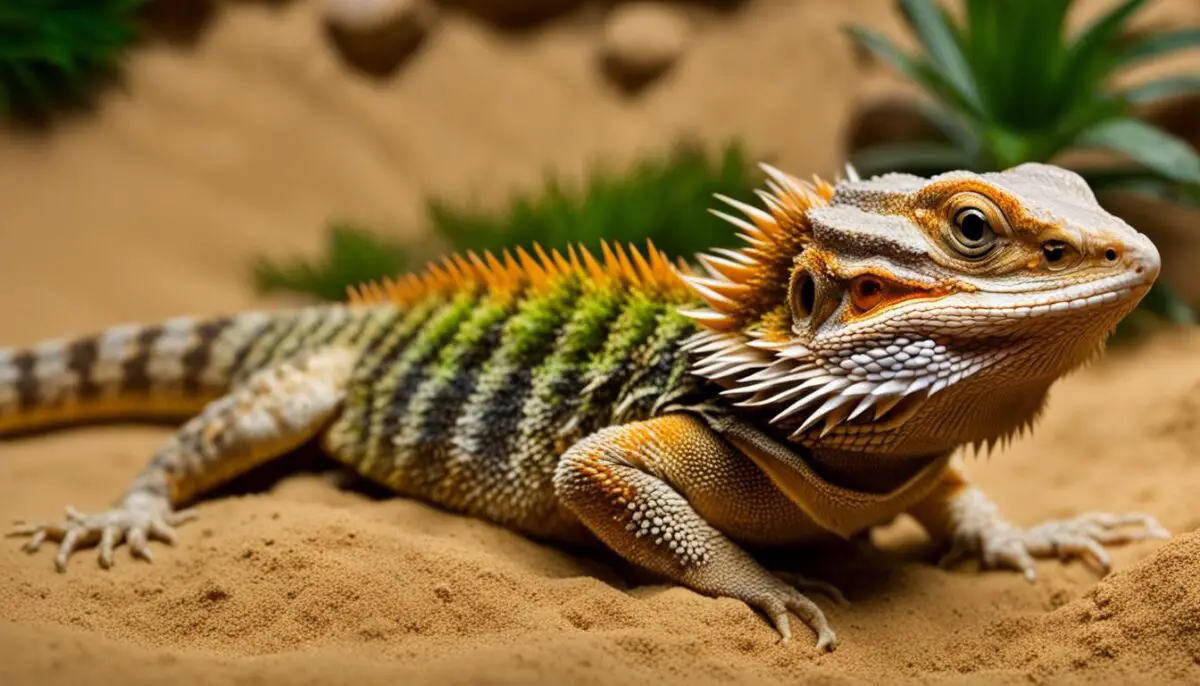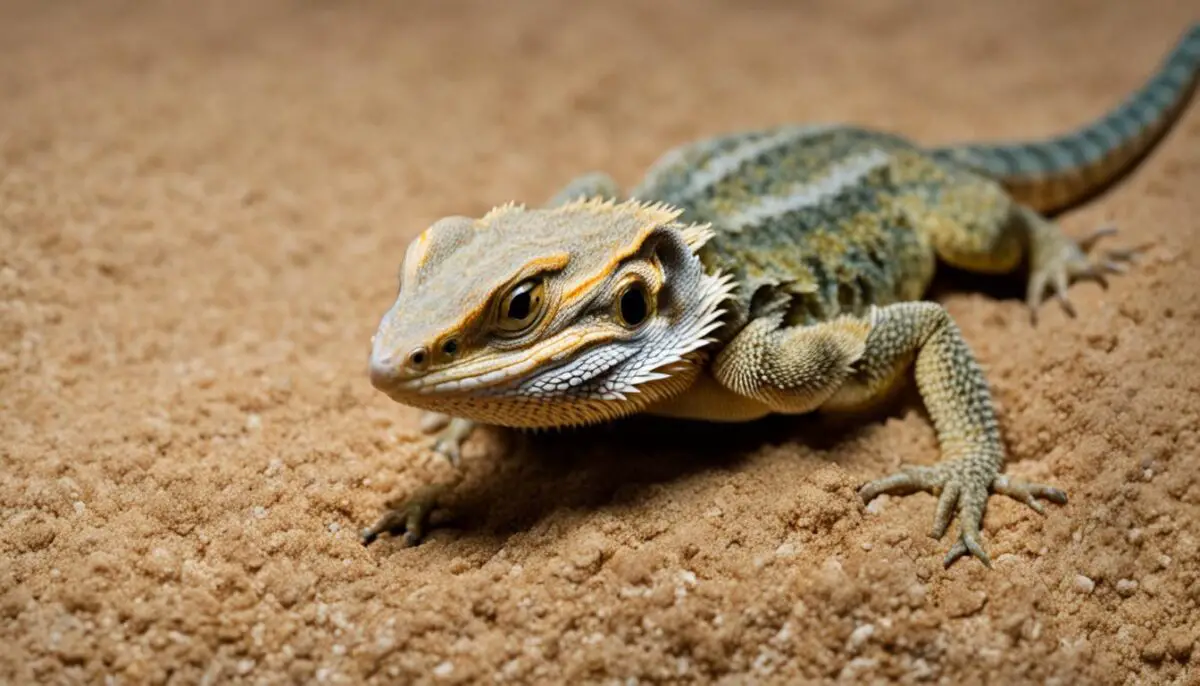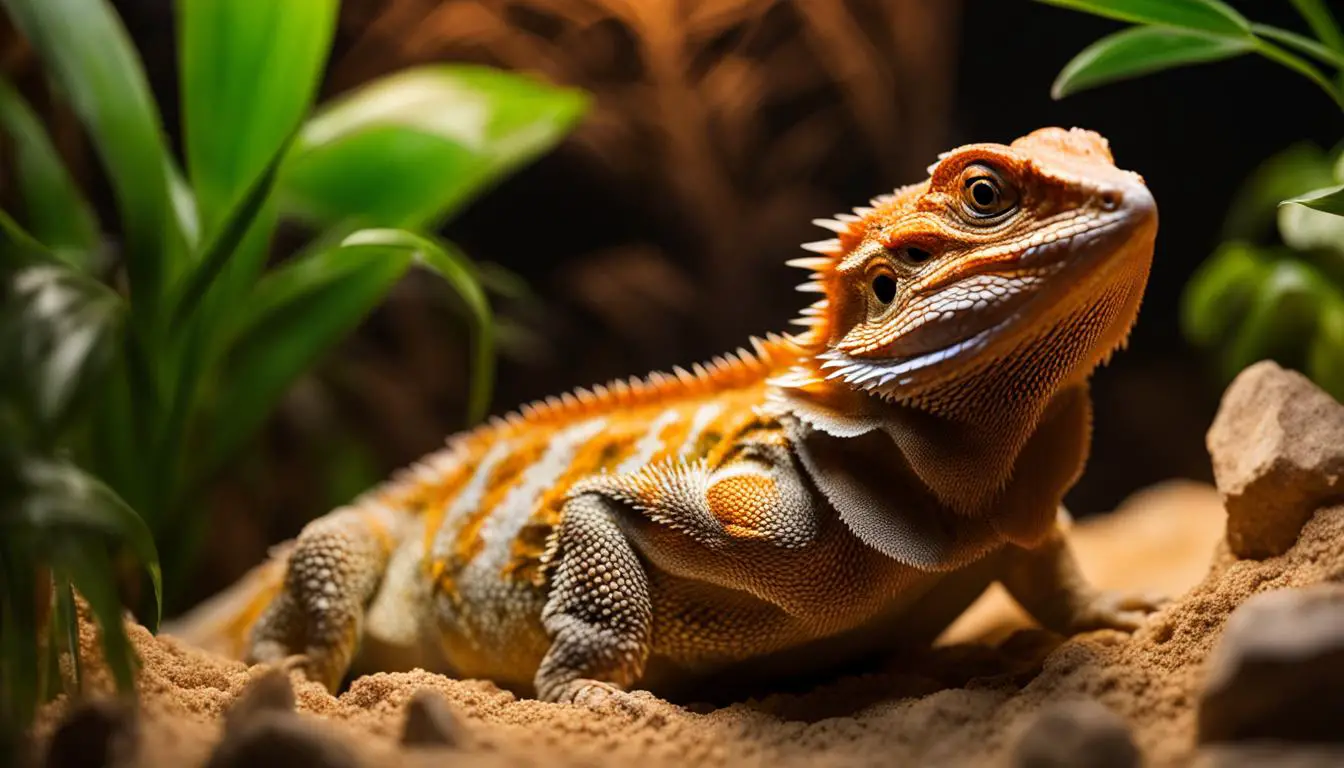When it comes to the well-being of our beloved bearded dragons, selecting the right substrate for their enclosures is a crucial decision. One type of substrate that sparks controversy and concerns among reptile enthusiasts is calci sand. However, it is important to separate fact from fiction and understand the risks and benefits associated with this popular reptile substrate.
Calci sand is made from calcium carbonate, the same substance found in supplements recommended for bearded dragons. It dissolves easily in their digestive system and clumps up only when exposed to air and heat outside of their bodies. While there is a perception that calci sand can cause impaction, the truth is that proper husbandry and nutrition play a more significant role in minimizing the risk of impaction issues.
Impaction, a condition where the digestive tract becomes blocked, is commonly attributed to factors such as inadequate hydration, low basking temperatures, or high parasite loads. Studies have shown that food-based impaction, rather than substrate-related issues, is the most frequently encountered problem among reptile veterinarians.
Key Takeaways:
- Calci sand is made from calcium carbonate, the same component found in bearded dragon supplements.
- Impaction issues often associated with calci sand are more likely caused by improper husbandry or nutrition.
- Proper hydration, basking temperatures, and parasite control are crucial to minimizing impaction risks.
- Food-based impaction is the most common impaction issue seen by reptile veterinarians.
- Testing substrates, seeking advice from experienced reptile keepers, and making informed decisions are essential for optimal bearded dragon care.
Understanding Bearded Dragon Substrates
Bearded dragon owners have engaged in heated debates over the choice of substrates for their reptiles’ enclosures. Some advocate for reptile carpet, while others prefer loose substrates. When it comes to loose substrates, there is a wide variety of options available, each with its own advantages and disadvantages.
Impaction, a health condition that can cause mobility issues or even death, is often associated with loose substrates. However, it is important to note that loose particle substrates alone will not cause impaction if all other husbandry requirements are met. It is more commonly observed in bearded dragons suffering from malnutrition or other underlying health issues.
High-quality sand-based substrates, such as natural Australian sand/soil, soft natural sand with a fine texture, or super fine quartz sand, are considered the best options as they closely mimic the bearded dragon’s natural environment. These substrates allow for burrowing and digging, providing enrichment to the enclosure.
Other substrates such as reptile carpet or artificial grass can also be used, but they may not offer the same level of natural environment and may have drawbacks such as bacterial growth or the risk of claws getting stuck.
To ensure the health and safety of your bearded dragon, it is important to avoid certain substrates, including:
- Calcium sand
- Silica sand
- Children’s play sand
- Ground nut shell
- Wood products
- Linoleum
- Shelf liner
- Reptile carpet
These substrates pose potential health risks and impaction dangers to your bearded dragon.
To summarize, when considering substrates for your bearded dragon’s enclosure, opt for high-quality sand-based substrates that closely resemble their natural habitat. Avoid substrates that can cause health issues and impaction risks. By selecting the right substrate and ensuring proper husbandry practices, you can provide a safe and enriching environment for your beloved reptile companion.

// Adding visible class to the img tag for center alignment
document.querySelector('img').classList.add('visible');
Choosing the Right Substrate for Bearded Dragons
The choice of substrate for bearded dragons depends on their unique needs, your personal preferences, and the lifestyle you provide for your reptile companion. When selecting a substrate, it is important to consider options that closely resemble the natural habitat of bearded dragons. Here are some recommendations for the best substrate choices:
- Natural Australian sand/soil: This substrate closely mimics the environment of bearded dragons, allowing them to dig and burrow as they would in the wild. It provides enrichment and promotes natural behaviors.
- Soft natural sand: This fine-textured sand provides a comfortable surface for your bearded dragon to walk on and allows for burrowing opportunities.
- Super fine quartz sand: Similar to soft natural sand, this substrate offers a suitable environment for your bearded dragon to explore and engage in natural behaviors.
While these loose substrates are considered optimal, there are alternative options available:
- Reptile carpet: This provides a clean and easily maintainable surface for your bearded dragon’s enclosure. However, it may not offer the same level of natural environment as loose substrates.
- Slate tiles: These tiles create a solid and durable surface for your bearded dragon’s habitat. They are easy to clean and provide a natural aesthetic.
- Paper towels or newspaper: These materials can be used temporarily or for easy cleanup. Although they are not as aesthetically pleasing, they offer a clean and hygienic environment.
It is crucial to avoid substrates that pose potential health risks to your bearded dragon. Substrates such as calcium sand, vitamin sand, ground nut shell, wood products, linoleum, shelf liner, and reptile carpet should be avoided to ensure the safety and well-being of your pet.
To prevent accidental substrate ingestion, proper husbandry practices should be maintained when using loose substrates. Ensure temperature parameters are appropriate, provide a balanced diet supplemented with calcium and other necessary nutrients, and regularly clean the enclosure and replace the substrate when needed.
Choosing the right substrate for your bearded dragon is an important decision that can contribute to their overall health and happiness. Consider their natural habitat, your personal preferences, and the specific needs of your pet when making your choice.

Debunking the Myth About Sand Impaction
Sand impaction in bearded dragons has generated a lot of discussion and controversy within the reptile community. However, research and accounts from experienced sources have challenged the notion that sand alone is the main cause of impaction in these reptiles. In fact, a study conducted in 2017 revealed that despite the majority of bearded dragons being housed on loose substrates like sand, very few cases of impaction were reported.
Impaction in bearded dragons is more likely to be influenced by other factors such as dehydration, low basking temperatures, or high parasite loads. It’s important to note that bearded dragons are naturally adapted to thrive on thick layers of packed sand, which consist of fine sand, silt, clay, and gravel, in their Australian habitat.
When using high-quality sand substrates that closely mimic their natural environment and applying proper husbandry practices, the risk of impaction becomes minimal. Regular spot-cleaning and substrate replacement every 3-6 months can further contribute to maintaining a clean and odor-free habitat for these beloved reptiles.
Expert Insights:
“Sand impaction is one of those misconceptions that has been perpetuated over the years. While it’s essential to ensure proper husbandry and keep an eye on any potential dietary issues, sand alone is not the primary culprit. Bearded dragons are well adapted to live on sand substrates as long as we provide them with the appropriate conditions. It’s about striking a balance and replicating their natural habitat as closely as possible.”
– Dr. Melissa Reynolds, Reptile Veterinarian
Debunking Common Misconceptions:
- Sand alone does not cause impaction in bearded dragons.
- Impaction is more likely influenced by dehydration, low basking temperatures, or high parasite loads.
- Bearded dragons are naturally adapted to live on sand substrates, resembling their natural habitat.
- Using high-quality sand substrates and practicing proper husbandry minimizes the risk of impaction.
- Regular spot-cleaning and substrate replacement help maintain a clean and odor-free environment.
By dispelling the myth surrounding sand impaction in bearded dragons, it becomes clear that providing a suitable and naturalistic habitat with high-quality sand substrates is a safe and viable option for these reptiles.
Conclusion
In conclusion, the use of calci sand as a substrate for bearded dragons remains a topic of debate. While it has gained a bad reputation, the risks associated with calci sand may be overstated. Other factors, such as poor husbandry or nutrition, are more likely to contribute to impaction issues.
Choosing the right substrate for bearded dragons is crucial, and options such as natural Australian sand/soil, soft natural sand, or super fine quartz sand are considered the best choices. These substrates closely resemble the bearded dragon’s natural environment, allowing for natural behaviors like burrowing and digging.
It is important to avoid substrates that pose health risks, such as calcium sand and vitamin sand. These substrates can clump up and potentially lead to impaction if ingested in large amounts. Additionally, substrates like ground nut shell, wood products, linoleum, shelf liner, and reptile carpet should be avoided due to their potential health risks.
When using loose substrates, it is essential to maintain proper husbandry practices, including regular spot-cleaning and substrate replacement every 3-6 months. Adequate temperature parameters and a balanced diet with proper supplementation are also crucial to prevent accidental substrate ingestion.
By understanding the facts and considering the individual needs of your bearded dragon, you can make an informed decision about the best substrate for your reptile companion. Remember to prioritize the health and well-being of your bearded dragon when selecting a substrate.
FAQ
Is calci sand safe for bearded dragons?
According to various sources, impaction issues often associated with calci sand are more likely caused by other factors such as improper husbandry or nutrition. It is important to ensure proper husbandry, temperature parameters, and diet/supplementation when using calci sand as a substrate.
What are the best substrates for bearded dragons?
Optimal substrates that closely resemble the natural habitat of bearded dragons include natural Australian sand/soil, soft natural sand, and super fine quartz sand. These substrates allow for burrowing and digging, adding enrichment to the enclosure.
Are reptile carpet or artificial grass safe substrates for bearded dragons?
Reptile carpet or artificial grass can be used as substrates for bearded dragons, but they may not provide the same level of natural environment. They also have drawbacks such as bacterial growth or the risk of claws getting stuck.
Should I avoid using calcium sand as a substrate for my bearded dragon?
Yes, it is important to avoid substrates such as calcium sand, silica sand, children’s play sand, ground nut shell, wood products, linoleum, shelf liner, and reptile carpet due to potential health risks and impaction dangers.
Can sand alone cause impaction in bearded dragons?
Research and observations suggest that sand alone does not cause impaction. Impaction is more likely caused by factors such as dehydration, low basking temperatures, or high parasite loads. When using high-quality sand substrates and following proper husbandry practices, the risk of impaction is minimal.
How often should I clean and replace the substrate in my bearded dragon’s enclosure?
Regular spot-cleaning and substrate replacement every 3-6 months is recommended to maintain a clean and odor-free environment for your bearded dragon.


